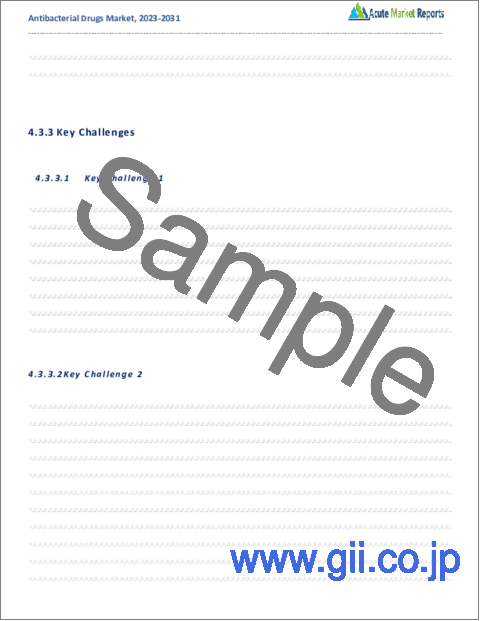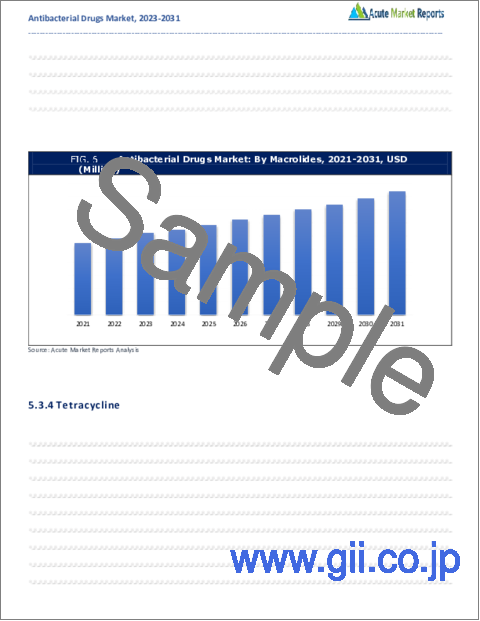|
|
市場調査レポート
商品コード
1166120
抗菌薬の世界市場:成長、将来の見通し、競合分析(2022年~2030年)Antibacterial Drugs Market - Growth, Future Prospects and Competitive Analysis, 2022 - 2030 |
||||||
| 抗菌薬の世界市場:成長、将来の見通し、競合分析(2022年~2030年) |
|
出版日: 2022年08月19日
発行: Acute Market Reports
ページ情報: 英文 118 Pages
納期: 即日から翌営業日
|
- 全表示
- 概要
- 図表
- 目次
世界の抗菌薬市場は、予測期間中の2022年~2030年の間に緩やかな成長を遂げる見通しです。しかし、細菌感染症に対する新規治療への需要の高まりや人口の高齢化により、多様な抗菌薬の薬剤クラスが著しく成長すると期待されます。
当レポートでは、世界の抗菌薬市場について調査分析し、市場動向、市場力学、セグメント別・地域別の市場分析、競合情勢、企業プロファイルなど、体系的な情報を提供しています。
目次
第1章 序文
- レポートの説明
- レポートの目的
- 対象者
- 主要な製品
- 市場の内訳
- 調査手法
- フェーズI:2次調査
- フェーズII:1次調査
- フェーズIII:専門家別審査
- 前提条件
- 採用されたアプローチ
第2章 エグゼクティブサマリー
- 市場スナップショット:世界の抗菌薬市場
- 世界の抗菌薬市場:薬剤クラス別(2021年)
- 世界の抗菌薬市場:地域別(2021年)
- COVID-19の影響
- 魅力的な投資提案:地域別(2021年)
- 競合分析
- 主要な抗菌薬市場ベンダーの市場ポジショニング
- 抗菌薬市場ベンダーが採用する戦略
- 主要な業界戦略
第3章 抗菌薬市場:ビジネスの見通しと市場力学
- イントロダクション
- 世界の抗菌薬の市場価値(2020年~2030年)
- 市場力学
- 市場促進要因
- 市場抑制要因
- 主要な課題
- 主要な機会
- 促進要因と抑制要因の影響分析
- シーソー分析
- ポーターのファイブフォースモデル
- 供給企業の交渉力
- 買い手の交渉力
- 代替品の脅威
- 新規参入業者の脅威
- 競争企業間の敵対関係
- PESTEL分析
- 政治情勢
- 経済情勢
- 技術情勢
- 法的情勢
- 社会情勢
第4章 抗菌薬市場:薬剤クラス別(2020年~2030年)
- 市場概要
- 成長・収益分析:2021年対2030年
- 市場の内訳
- アミノグリコシド
- ベータラクタム
- テトラサイクリン系
- スルホンアミド
- キノロン
- マクロライド
- フェニコール
第5章 北米の抗菌薬市場(2020年~2030年)
- 市場概要
- 薬剤クラス別(2020年~2030年)
- 地域別(2020年~2030年)
- 北米
第6章 英国・EUの抗菌薬市場(2020年~2030年)
- 市場概要
- 薬剤クラス別(2020年~2030年)
- 地域別(2020年~2030年)
- 英国・EU
第7章 アジア太平洋の抗菌薬市場(2020年~2030年)
- 市場概要
- 薬剤クラス別(2020年~2030年)
- 地域別(2020年~2030年)
- アジア太平洋
第8章 ラテンアメリカの抗菌薬市場(2020年~2030年)
- 市場概要
- 薬剤クラス別(2020年~2030年)
- 地域別(2020年~2030年)
- ラテンアメリカ
第9章 中東・アフリカの抗菌薬市場(2020年~2030年)
- 市場概要
- 薬剤クラス別(2020年~2030年)
- 地域別(2020年~2030年)
- 中東・アフリカ
第10章 企業プロファイル
- Pfizer Inc.
- Novartis AG
- Merck & Co.
- Pfizer Inc.
- Novartis AG
- Merck & Co.
- Astra Zeneca plc
- Johnson & Johnson Limited
- Abbott Laboratories
- Eli Lilly and Company
- Sanofi SA
- Bristol-Myers Squibb Company
- Bayer AG
- GlaxoSmithKline plc
- Sanofi SA
- Bayer AG
- GlaxoSmithKline plc
List of Tables
- TABLE 1 Global Antibacterial Drugs Market By Drug Class, 2020-2030, USD (Million)
- TABLE 2 North America Antibacterial Drugs Market By Drug Class, 2020-2030, USD (Million)
- TABLE 3 UK and European Union Antibacterial Drugs Market By Drug Class, 2020-2030, USD (Million)
- TABLE 4 Asia Pacific Antibacterial Drugs Market By Drug Class, 2020-2030, USD (Million)
- TABLE 5 Latin America Antibacterial Drugs Market By Drug Class, 2020-2030, USD (Million)
- TABLE 6 Middle East and Africa Antibacterial Drugs Market By Drug Class, 2020-2030, USD (Million)
List of Figures
- FIG. 1 Global Antibacterial Drugs Market: Market Coverage
- FIG. 2 Research Methodology and Data Sources
- FIG. 3 Market Size Estimation - Top Down & Bottom-Up Approach
- FIG. 4 Global Antibacterial Drugs Market: Quality Assurance
- FIG. 5 Global Antibacterial Drugs Market, By Drug Class, 2021
- FIG. 6 Global Antibacterial Drugs Market, By Geography, 2021
- FIG. 7 Global Antibacterial Drugs Market, By Drug Class, 2021 Vs 2030, %
- FIG. 8 U.S. Antibacterial Drugs Market (US$ Million), 2020 - 2030
- FIG. 9 Canada Antibacterial Drugs Market (US$ Million), 2020 - 2030
- FIG. 10 Rest of North America Antibacterial Drugs Market (US$ Million), 2020 - 2030
- FIG. 11 UK Antibacterial Drugs Market (US$ Million), 2020 - 2030
- FIG. 12 Germany Antibacterial Drugs Market (US$ Million), 2020 - 2030
- FIG. 13 Spain Antibacterial Drugs Market (US$ Million), 2020 - 2030
- FIG. 14 Italy Antibacterial Drugs Market (US$ Million), 2020 - 2030
- FIG. 15 France Antibacterial Drugs Market (US$ Million), 2020 - 2030
- FIG. 16 Rest of Europe Antibacterial Drugs Market (US$ Million), 2020 - 2030
- FIG. 17 China Antibacterial Drugs Market (US$ Million), 2020 - 2030
- FIG. 18 Japan Antibacterial Drugs Market (US$ Million), 2020 - 2030
- FIG. 19 India Antibacterial Drugs Market (US$ Million), 2020 - 2030
- FIG. 20 Australia Antibacterial Drugs Market (US$ Million), 2020 - 2030
- FIG. 21 South Korea Antibacterial Drugs Market (US$ Million), 2020 - 2030
- FIG. 22 Rest of Asia Antibacterial Drugs Market (US$ Million), 2020 - 2030
- FIG. 23 Brazil Antibacterial Drugs Market (US$ Million), 2020 - 2030
- FIG. 24 Mexico Antibacterial Drugs Market (US$ Million), 2020 - 2030
- FIG. 25 Rest of Latin America Antibacterial Drugs Market (US$ Million), 2020 - 2030
- FIG. 26 GCC Antibacterial Drugs Market (US$ Million), 2020 - 2030
- FIG. 27 Africa Antibacterial Drugs Market (US$ Million), 2020 - 2030
- FIG. 28 Rest of Middle East and Africa Antibacterial Drugs Market (US$ Million), 2020 - 2030
This report on global antibacterial drugs market studies various drug classes used for treatment of bacterial infections along with pipeline analysis of upcoming potential drugs. Bacterial infection, irrespective of its etiology is an important concern in patients with cirrhosis since it is associated with increased morbidity and mortality. According to World Health Organization (WHO), cirrhotic patients from developed countries indicate urinary tract infections (12 - 29%) to be the most frequent cause for bacterial sepsis followed by spontaneous bacterial peritonitis (15 - 23%), respiratory tract infection (6 - 10%) and bacteremia (4-9%).
For the purpose of this study, the various drug classes studied include aminoglycosides, beta-lactams, tetracyclines, sulfonamides, quinolones, macrolides, phenicols and miscellaneous antibacterials.
The pipeline analysis for antibacterial drugs market comprises projected market sales of Phase III drugs estimated till 2029. The phase III drugs included in the pipeline analysis are solithromycin (Cempra, Inc.), VivaGel/ SPL7013 (Starpharma Holdings Limited), surotomycin (Merck & Co.), MK-3415A (Merck & Co.) and others. The report also covers qualitative information associated with the drugs under phase II and I of the clinical trials.
The geographic segmentation of the global antibacterial drugs market is performed for the regions North America, Europe, Asia Pacific and Rest of the World markets. The regions are also further sub-segmented on the basis of major countries.
According to market stakeholders, bacterial infections cause an enormous financial and physical burden of disease throughout the globe and kill millions of humans and animals. A few most common bacterial infections are pneumonia, diarrhea and meningitis, genito-urinary infections and blood infections. Recently hospital acquired diseases such as tuberculosis, pneumonia, and others are on the rise in many parts of the world. Resistance to antibiotics is now widespread among bacteria and is increasing at an alarming rate.
In base year 2021, beta-lactams accounted for the largest market share of 55.8% of the global antibacterial drugs market followed by the quinolones. In the near future these drug classes are expected to experience a decline in their market share during the forecast period 2016 to 2029 because leading brands will lose their market exclusivity, coupled with high rate of clinical trial failures, rising number of drug resistant bacterial strains and high influx of generic drugs. Thus, on the basis of the factors mentioned above, the global antibacterial drugs market is expected to witness slow growth during the forecast period 2022 to 2030. Although, the miscellaneous antibacterial drug class is expected to project noticeable growth along with rising demand for novel therapies against bacterial infections and aging population.
In base year 2021, it was observed that Asia Pacific dominated the overall market and is also projected to witness the fastest growth during the forecast period 2020 - 2030. The key factors assisting the growth of Asia Pacific antibacterial drugs market are it accounts for the largest infected population in the world with a variety of bacterial infections such as pneumonia, tuberculosis and tetanus, presence of large number of manufacturers of active pharmaceutical ingredient and generic drugs, high disposable income, rising geriatric population, and emerging healthcare infrastructure. North America, followed by Europe, is the second largest antibacterial drugs market globally in terms of revenue. North America and Europe are anticipated to witness slow growth over the forecast period due to stringent regulatory policies, abridged product lifecycle, and generic penetration.
Historical & Forecast Period
This study report represents analysis of each segment from 2020 to 2030 considering 2021 as the base year. Compounded Annual Growth Rate (CAGR) for each of the respective segments estimated for the forecast period of 2022 to 2030.
The current report comprises of quantitative market estimations for each micro market for every geographical region and qualitative market analysis such as micro and macro environment analysis, market trends, competitive intelligence, segment analysis, porters five force model, top winning strategies, top investment markets, emerging trends and technological analysis, case studies, strategic conclusions and recommendations and other key market insights.
Research Methodology
The complete research study was conducted in three phases, namely: secondary research, primary research, and expert panel review. key data point that enables the estimation of Antibacterial Drugs market are as follows:
Research and development budgets of manufacturers and government spending
Revenues of key companies in the market segment
Number of end users and consumption volume, price and value.
Geographical revenues generate by countries considered in the report
Micro and macro environment factors that are currently influencing the Antibacterial Drugs market and their expected impact during the forecast period.
Market forecast was performed through proprietary software that analyzes various qualitative and quantitative factors. Growth rate and CAGR were estimated through intensive secondary and primary research. Data triangulation across various data points provides accuracy across various analyzed market segments in the report. Application of both top down and bottom-up approach for validation of market estimation assures logical, methodical and mathematical consistency of the quantitative data.
Market Segmentation
Drug Class
Aminoglycosides
Beta-Lactams
Tetracyclines
Sulfonamides
Quinolones
Macrolides
Phenicols
Region Segment (2020-2030; US$ Million)
North America
U.S.
Canada
Rest of North America
UK and European Union
UK
Germany
Spain
Italy
France
Rest of Europe
Asia Pacific
China
Japan
India
Australia
South Korea
Rest of Asia Pacific
Latin America
Brazil
Mexico
Rest of Latin America
Middle East and Africa
GCC
Africa
Rest of Middle East and Africa
Global Impact of Covid-19 Segment (2020-2021; US$ Million )
Pre Covid-19 situation
Post Covid-19 situation
Key questions answered in this report
What are the key micro and macro environmental factors that are impacting the growth of Antibacterial Drugs market?
What are the key investment pockets with respect to product segments and geographies currently and during the forecast period?
Estimated forecast and market projections up to 2030.
Which segment accounts for the fastest CAGR during the forecast period?
Which market segment holds a larger market share and why?
Are low and middle-income economies investing in the Antibacterial Drugs market?
Which is the largest regional market for Antibacterial Drugs market?
What are the market trends and dynamics in emerging markets such as Asia Pacific, Latin America, and Middle East & Africa?
Which are the key trends driving Antibacterial Drugs market growth?
Who are the key competitors and what are their key strategies to enhance their market presence in the Antibacterial Drugs market worldwide?
Table of Contents
1. Preface
- 1.1. Report Description
- 1.1.1. Purpose of the Report
- 1.1.2. Target Audience
- 1.1.3. Key Offerings
- 1.2. Market Segmentation
- 1.3. Research Methodology
- 1.3.1. Phase I - Secondary Research
- 1.3.2. Phase II - Primary Research
- 1.3.3. Phase III - Expert Panel Review
- 1.3.4. Assumptions
- 1.3.5. Approach Adopted
2. Executive Summary
- 2.1. Market Snapshot: Global Antibacterial Drugs Market
- 2.2. Global Antibacterial Drugs Market, By Drug Class, 2021 (US$ Million)
- 2.3. Global Antibacterial Drugs Market, By Geography, 2021 (US$ Million)
- 2.4. Impact of Covid 19
- 2.5. Attractive Investment Proposition by Geography, 2021
- 2.6. Competitive Analysis
- 2.6.1. Market Positioning of Key Antibacterial Drugs Market Vendors
- 2.6.2. Strategies Adopted by Antibacterial Drugs Market Vendors
- 2.6.3. Key Industry Strategies
3. Antibacterial Drugs Market: Business Outlook & Market Dynamics
- 3.1. Introduction
- 3.2. Global Antibacterial Drugs Market Value, 2020 - 2030, (US$ Million)
- 3.3. Market Dynamics
- 3.3.1. Market Drivers
- 3.3.2. Market Restraints
- 3.3.3. Key Challenges
- 3.3.4. Key Opportunities
- 3.4. Impact Analysis of Drivers and Restraints
- 3.5. See-Saw Analysis
- 3.6. Porter's Five Force Model
- 3.6.1. Supplier Power
- 3.6.2. Buyer Power
- 3.6.3. Threat Of Substitutes
- 3.6.4. Threat Of New Entrants
- 3.6.5. Competitive Rivalry
- 3.7. PESTEL Analysis
- 3.7.1. Political Landscape
- 3.7.2. Economic Landscape
- 3.7.3. Technology Landscape
- 3.7.4. Legal Landscape
- 3.7.5. Social Landscape
4. Antibacterial Drugs Market: By Drug Class, 2020-2030, USD (Million)
- 4.1. Market Overview
- 4.2. Growth & Revenue Analysis: 2021 Versus 2030
- 4.3. Market Segmentation
- 4.3.1. Aminoglycosides
- 4.3.2. Beta-Lactams
- 4.3.3. Tetracyclines
- 4.3.4. Sulfonamides
- 4.3.5. Quinolones
- 4.3.6. Macrolides
- 4.3.7. Phenicols
5. North America Antibacterial Drugs Market, 2020-2030, USD (Million)
- 5.1. Market Overview
- 5.2. Antibacterial Drugs Market: By Drug Class, 2020-2030, USD (Million)
- 5.3.Antibacterial Drugs Market: By Region, 2020-2030, USD (Million)
- 5.3.1.North America
- 5.3.1.1. U.S.
- 5.3.1.2. Canada
- 5.3.1.3. Rest of North America
- 5.3.1.North America
6. UK and European Union Antibacterial Drugs Market, 2020-2030, USD (Million)
- 6.1. Market Overview
- 6.2. Antibacterial Drugs Market: By Drug Class, 2020-2030, USD (Million)
- 6.3.Antibacterial Drugs Market: By Region, 2020-2030, USD (Million)
- 6.3.1.UK and European Union
- 6.3.1.1. UK
- 6.3.1.2. Germany
- 6.3.1.3. Spain
- 6.3.1.4. Italy
- 6.3.1.5. France
- 6.3.1.6. Rest of Europe
- 6.3.1.UK and European Union
7. Asia Pacific Antibacterial Drugs Market, 2020-2030, USD (Million)
- 7.1. Market Overview
- 7.2. Antibacterial Drugs Market: By Drug Class, 2020-2030, USD (Million)
- 7.3.Antibacterial Drugs Market: By Region, 2020-2030, USD (Million)
- 7.3.1.Asia Pacific
- 7.3.1.1. China
- 7.3.1.2. Japan
- 7.3.1.3. India
- 7.3.1.4. Australia
- 7.3.1.5. South Korea
- 7.3.1.6. Rest of Asia Pacific
- 7.3.1.Asia Pacific
8. Latin America Antibacterial Drugs Market, 2020-2030, USD (Million)
- 8.1. Market Overview
- 8.2. Antibacterial Drugs Market: By Drug Class, 2020-2030, USD (Million)
- 8.3.Antibacterial Drugs Market: By Region, 2020-2030, USD (Million)
- 8.3.1.Latin America
- 8.3.1.1. Brazil
- 8.3.1.2. Mexico
- 8.3.1.3. Rest of Latin America
- 8.3.1.Latin America
9. Middle East and Africa Antibacterial Drugs Market, 2020-2030, USD (Million)
- 9.1. Market Overview
- 9.2. Antibacterial Drugs Market: By Drug Class, 2020-2030, USD (Million)
- 9.3.Antibacterial Drugs Market: By Region, 2020-2030, USD (Million)
- 9.3.1.Middle East and Africa
- 9.3.1.1. GCC
- 9.3.1.2. Africa
- 9.3.1.3. Rest of Middle East and Africa
- 9.3.1.Middle East and Africa
10. Company Profile
- 10.1. Pfizer Inc.
- 10.1.1. Company Overview
- 10.1.2. Financial Performance
- 10.1.3. Product Portfolio
- 10.1.4. Strategic Initiatives
- 10.2. Novartis AG
- 10.2.1. Company Overview
- 10.2.2. Financial Performance
- 10.2.3. Product Portfolio
- 10.2.4. Strategic Initiatives
- 10.3. Merck & Co.
- 10.3.1. Company Overview
- 10.3.2. Financial Performance
- 10.3.3. Product Portfolio
- 10.3.4. Strategic Initiatives
- 10.4. Pfizer Inc.
- 10.4.1. Company Overview
- 10.4.2. Financial Performance
- 10.4.3. Product Portfolio
- 10.4.4. Strategic Initiatives
- 10.5. Novartis AG
- 10.5.1. Company Overview
- 10.5.2. Financial Performance
- 10.5.3. Product Portfolio
- 10.5.4. Strategic Initiatives
- 10.6. Merck & Co.
- 10.6.1. Company Overview
- 10.6.2. Financial Performance
- 10.6.3. Product Portfolio
- 10.6.4. Strategic Initiatives
- 10.7. Astra Zeneca plc
- 10.7.1. Company Overview
- 10.7.2. Financial Performance
- 10.7.3. Product Portfolio
- 10.7.4. Strategic Initiatives
- 10.8. Johnson & Johnson Limited
- 10.8.1. Company Overview
- 10.8.2. Financial Performance
- 10.8.3. Product Portfolio
- 10.8.4. Strategic Initiatives
- 10.9. Abbott Laboratories
- 10.9.1. Company Overview
- 10.9.2. Financial Performance
- 10.9.3. Product Portfolio
- 10.9.4. Strategic Initiatives
- 10.10. Eli Lilly and Company
- 10.10.1. Company Overview
- 10.10.2. Financial Performance
- 10.10.3. Product Portfolio
- 10.10.4. Strategic Initiatives
- 10.11. Sanofi SA
- 10.11.1. Company Overview
- 10.11.2. Financial Performance
- 10.11.3. Product Portfolio
- 10.11.4. Strategic Initiatives
- 10.12. Bristol-Myers Squibb Company
- 10.12.1. Company Overview
- 10.12.2. Financial Performance
- 10.12.3. Product Portfolio
- 10.12.4. Strategic Initiatives
- 10.13. Bayer AG
- 10.13.1. Company Overview
- 10.13.2. Financial Performance
- 10.13.3. Product Portfolio
- 10.13.4. Strategic Initiatives
- 10.14. GlaxoSmithKline plc
- 10.14.1. Company Overview
- 10.14.2. Financial Performance
- 10.14.3. Product Portfolio
- 10.14.4. Strategic Initiatives
- 10.15. Sanofi SA
- 10.15.1. Company Overview
- 10.15.2. Financial Performance
- 10.15.3. Product Portfolio
- 10.15.4. Strategic Initiatives
- 10.16. Bayer AG
- 10.16.1. Company Overview
- 10.16.2. Financial Performance
- 10.16.3. Product Portfolio
- 10.16.4. Strategic Initiatives
- 10.17. GlaxoSmithKline plc
- 10.17.1. Company Overview
- 10.17.2. Financial Performance
- 10.17.3. Product Portfolio
- 10.17.4. Strategic Initiatives




